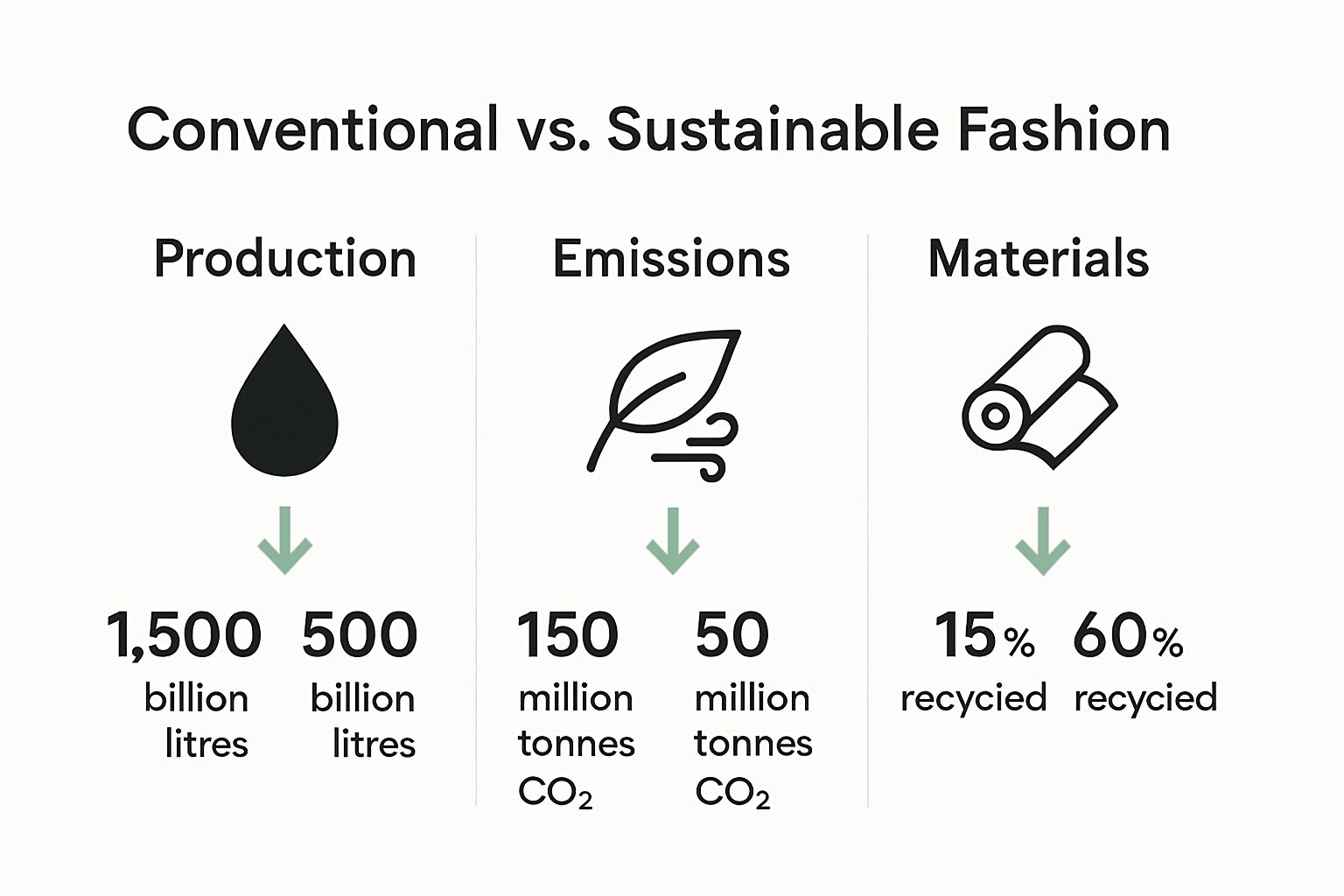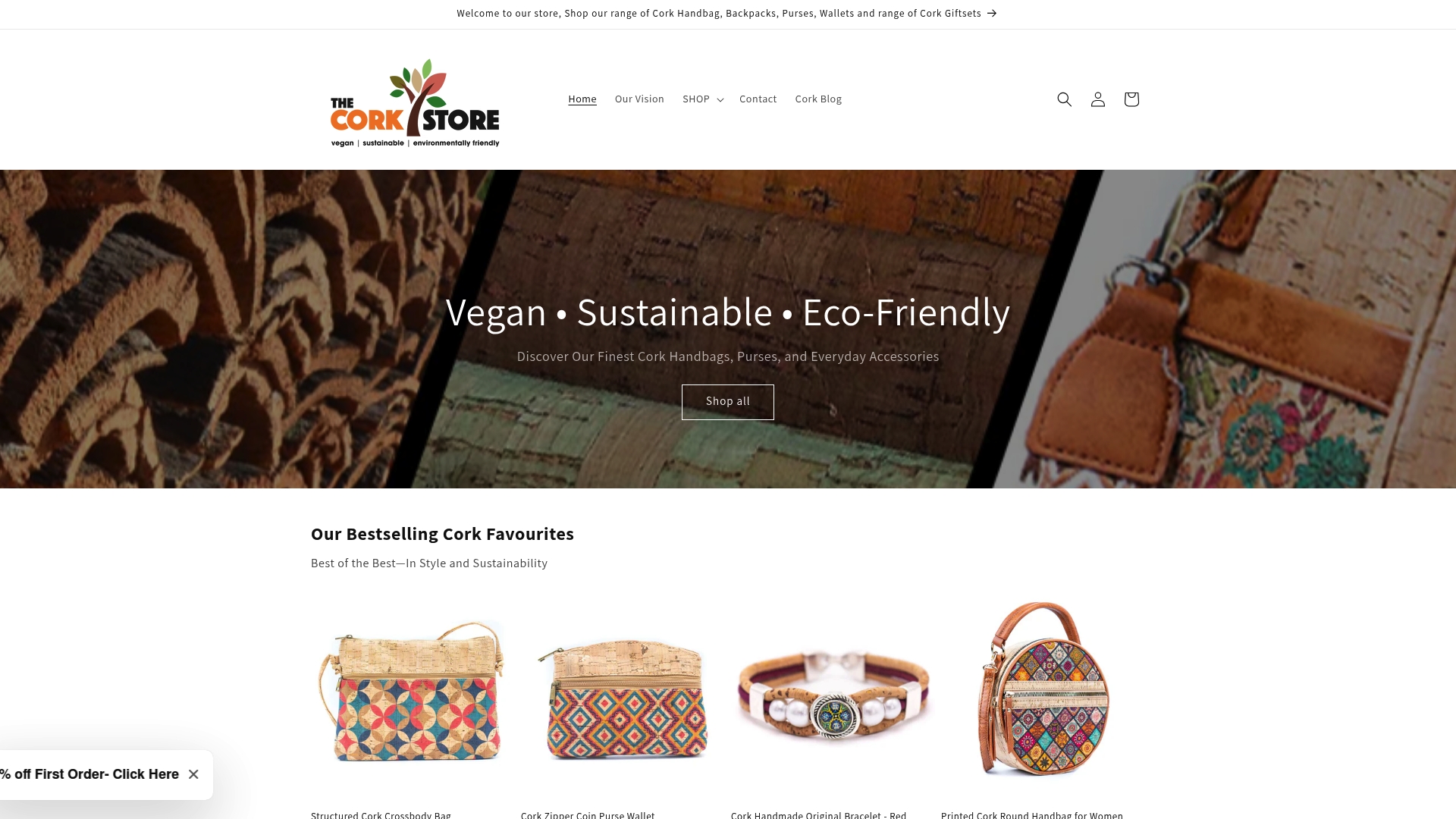
Understanding Sustainable Fashion Essentials for Eco-Conscious Living
Share
Sustainable fashion is changing the way we think about clothes. While most people focus on price or style, the real shock is that the fashion industry produces 1.2 billion tonnes of carbon dioxide every year—more than all international flights and shipping combined. The surprising bit? The biggest impact comes not just from what brands make, but from the choices we make every time we buy, wear, and toss away our clothes.
Table of Contents
- Defining Sustainable Fashion: Key Principles And Practices
- The Importance Of Sustainable Fashion For Our Planet
- How Sustainable Materials Impact Fashion Production
- Consumer Choices: Making Ethical Fashion Decisions
- The Future Of Sustainable Fashion: Trends And Innovations
Quick Summary
| Takeaway | Explanation |
|---|---|
| Sustainable fashion prioritises ecological and ethical production | It seeks to reduce environmental impact while ensuring fair labour practices in the fashion industry. |
| Adopt circular economy models for lasting impact | This includes recycling, reusing, and sustainable material usage to reduce waste and resources consumed. |
| Make conscious purchasing decisions | By researching brands and prioritising quality, consumers can influence sustainable practices and ethical labour conditions. |
| Embrace innovative materials and technologies | Utilizing eco-friendly materials and cutting-edge production methods can significantly lower the fashion industry’s ecological footprint. |
| Support local and small-scale producers | Buying from these businesses fosters community growth and promotes ethically produced goods with clear supply chains. |
Defining Sustainable Fashion: Key Principles and Practices
Sustainable fashion represents a transformative approach to clothing and accessory production that prioritises environmental responsibility, ethical manufacturing, and long-term ecological consciousness. Unlike traditional fashion models that emphasise rapid consumption and disposability, sustainable fashion seeks to create a holistic system that respects both human and environmental well-being.
The Core Philosophy of Sustainable Fashion
At its heart, sustainable fashion challenges the prevailing “take-make-dispose” model of clothing production. This approach recognises that fashion’s environmental footprint extends far beyond the final product, encompassing raw material extraction, manufacturing processes, transportation, usage, and eventual disposal. Our guide on how to spot sustainable fashion provides deeper insights into identifying genuine sustainable practices.
The key principles of sustainable fashion include:
- Minimising waste and environmental impact
- Protecting workers’ rights and ensuring fair labour practices
- Using renewable, recycled, or low-impact materials
- Promoting longevity and durability of clothing
- Encouraging circular economy models
Materials and Manufacturing: The Sustainable Approach
Sustainable fashion demands a radical reimagining of material selection and production techniques. This means moving beyond conventional fabrics like virgin cotton and synthetic materials towards more eco-friendly alternatives. According to research from the Ellen MacArthur Foundation, the textile industry can significantly reduce its environmental impact by adopting circular design principles.
Manufacturers committed to sustainable fashion invest in production methods that:
- Reduce water consumption
- Minimise chemical usage
- Implement energy-efficient technologies
- Ensure transparent and ethical supply chains
- Support local and small-scale production communities
By embracing these principles, sustainable fashion transforms from a niche concept to a comprehensive approach that recognises clothing as more than a commodity but as a reflection of environmental and social responsibility.
The Importance of Sustainable Fashion for Our Planet
Sustainable fashion represents far more than an aesthetic choice. It is a critical environmental strategy with profound implications for our global ecosystem. The traditional fashion industry has been a significant contributor to environmental degradation, generating substantial carbon emissions, waste, and resource depletion.
Environmental Impact of Conventional Fashion
The fashion industry operates as one of the most environmentally destructive sectors globally.
Research from the United Nations Environment Programme reveals that textile production generates approximately 1.2 billion tonnes of carbon dioxide equivalent per year, which surpasses the emissions of international flights and maritime shipping combined. This staggering statistic underscores the urgent need for sustainable alternatives.
The following table summarises key environmental challenges of conventional fashion alongside the solutions offered by sustainable fashion, supporting comparison and better understanding of their respective impacts.
| Environmental Challenge | Conventional Fashion | Sustainable Fashion Response |
|---|---|---|
| Water Consumption | Massive water usage during production | Reduced water use and efficient methods |
| Chemical Pollution | Extensive use of toxic dyes and finishes | Minimal chemical usage |
| Textile Waste | Large volumes sent to landfill | Promoting recycling and circularity |
| Carbon Emissions | High emissions throughout supply chain | Lower emissions via cleaner processes |
| Biodiversity Disruption | Habitat loss and pollution due to resource extraction | Focus on regenerative and local sourcing |

Key environmental challenges in conventional fashion include:
- Massive water consumption during fabric production
- Chemical pollution from textile dyeing processes
- Enormous quantities of textile waste in landfills
- High carbon emissions throughout manufacturing
- Significant biodiversity disruption
Transformative Potential of Sustainable Fashion Practices
Sustainable fashion offers a comprehensive solution to these environmental challenges. By understanding the role of eco-friendly materials in fashion, consumers and manufacturers can dramatically reduce their ecological footprint.
The transformative approaches include:
- Using recycled and renewable materials
- Implementing closed-loop production systems
- Reducing overall resource consumption
- Supporting regenerative agricultural practices
- Promoting longer product lifecycles
By embracing sustainable fashion, we can collectively mitigate environmental damage, protect natural resources, and create a more responsible approach to clothing production and consumption. This is not merely a trend but a necessary evolution towards ecological consciousness and responsible global citizenship.
How Sustainable Materials Impact Fashion Production
Sustainable materials represent a revolutionary approach to transforming fashion production, addressing the profound environmental challenges inherent in traditional textile manufacturing. By reimagining material selection and sourcing, the fashion industry can dramatically reduce its ecological footprint and create more responsible production systems.
Redefining Material Sourcing and Selection
Traditional fashion materials often involve extensive resource consumption and environmental degradation. Sustainable materials challenge this paradigm by prioritising renewable, recycled, and low-impact alternatives. Our comprehensive guide on sustainable materials explores the diverse range of eco-friendly options transforming the industry.
Key sustainable material characteristics include:
- Minimal water usage during production
- Reduced carbon emissions
- Biodegradability or recyclability
- Lower chemical and pesticide requirements
- Renewable or regenerative sourcing
Environmental and Economic Implications
Sustainable materials do more than minimise environmental impact. According to Textile Exchange research, these materials create significant economic opportunities by driving innovation, reducing long-term production costs, and meeting growing consumer demand for environmentally responsible products.
Transformative sustainable material innovations include:
- Organic cotton with reduced water consumption
- Recycled polyester from plastic waste
- Innovative plant-based leather alternatives
- Regenerated cellulose fibres like TENCEL
- Agricultural waste transformation into textiles
By embracing sustainable materials, fashion producers can create a more circular, responsible production ecosystem that respects planetary boundaries while delivering high-quality, aesthetically pleasing products.
This table provides an overview of some of the most prominent sustainable material innovations mentioned in the article, highlighting their defining features and environmental benefits.
| Material/Innovation | Key Features | Environmental Benefit |
|---|---|---|
| Organic Cotton | Produced with fewer pesticides, less water | Reduces water and chemical use |
| Recycled Polyester | Made from post-consumer plastic waste | Helps reduce landfill and reliance on oil |
| Plant-Based Leather Alternatives | Derived from renewable plant sources | Animal-free and biodegradable |
| Regenerated Cellulose Fibres (TENCEL) | Made from sustainably sourced wood pulp | Biodegradable and less polluting |
| Agricultural Waste Textiles | Transforms crop waste into fabric | Adds value to waste and lowers resource demand |
Consumer Choices: Making Ethical Fashion Decisions
Ethical fashion decisions represent a powerful mechanism for individual consumers to drive systemic change within the global fashion industry. By making intentional purchasing choices, consumers can significantly influence production practices, environmental sustainability, and labour conditions.
Understanding Consumer Impact
Every purchasing decision carries profound implications beyond the immediate transaction. Our guide on understanding sustainable bags for a greener future illustrates how conscious consumer choices can transform market dynamics and promote ecological responsibility.
Key considerations for ethical fashion decisions include:
- Researching brand sustainability credentials
- Prioritising quality over quantity
- Supporting transparent manufacturing processes
- Choosing durable, versatile garments
- Understanding material environmental impact
Practical Strategies for Ethical Consumption
According to McKinsey & Company’s sustainable fashion research, consumers increasingly demand transparency and sustainability. This shift enables practical strategies for making more responsible fashion choices.
Effective approaches to ethical fashion consumption include:
- Investing in timeless, multipurpose pieces
- Embracing second-hand and vintage shopping
- Supporting local and small-scale designers
- Maintaining and repairing existing clothing
- Selecting brands with demonstrable ethical practices
By approaching fashion consumption as a holistic decision-making process, consumers can become powerful agents of positive environmental and social transformation.

The Future of Sustainable Fashion: Trends and Innovations
Sustainable fashion represents a dynamic landscape of continuous transformation, driven by technological advancements, environmental consciousness, and innovative design approaches. The future of fashion is being reimagined through groundbreaking solutions that challenge traditional production paradigms and prioritise ecological responsibility.
Technological Innovations in Sustainable Design
Cutting-edge technologies are revolutionising sustainable fashion production. Discover the remarkable role of cork in sustainable fashion as an innovative, renewable material that exemplifies future-focused design strategies. Emerging technological trends demonstrate remarkable potential for reducing environmental impact.
Key technological innovations include:
- Biomaterial development from agricultural waste
- 3D printing of customised, zero-waste garments
- Artificial intelligence for sustainable design optimization
- Digital sampling to reduce physical prototype production
- Blockchain technology for supply chain transparency
Circular Economy and Systemic Transformation
According to McKinsey’s Fashion on Climate report, the fashion industry is experiencing a fundamental shift towards circular economic models. These approaches prioritise regenerative practices, material recycling, and long-term environmental sustainability.
Emergent circular fashion strategies encompass:
- Clothing rental and sharing platforms
- Advanced textile recycling technologies
- Modular design enabling garment repair and transformation
- Carbon-neutral production processes
- Closed-loop manufacturing systems
The future of sustainable fashion transcends mere trend status, representing a comprehensive reimagining of how clothing is conceived, produced, consumed, and ultimately recycled. By embracing innovation, collaboration, and systemic thinking, the fashion industry can become a powerful force for positive environmental change.
Take the Next Step in Eco-Conscious Style
Are you ready to put the essentials of sustainable fashion into practice? The article highlighted the urgent need to choose ethical materials and adopt conscious consumption habits. Now is the time to turn knowledge into meaningful action and make choices that reduce waste, support fair production, and protect our planet.

Start exploring cruelty-free, vegan accessories that reflect your values. Discover our curated collection of cork handbags, wallets, and sustainable gift sets at The Cork Store. Each piece combines style, durability, and environmental responsibility. Shop now for accessories that embody the core philosophy of eco-conscious living discussed in our article. Visit https://thecorkstore.co.uk and make your next purchase a vote for a greener future.
Frequently Asked Questions
What are the key principles of sustainable fashion?
Sustainable fashion focuses on minimising environmental impact, protecting workers’ rights, using eco-friendly materials, promoting longevity of garments, and encouraging circular economy models. To incorporate these principles into your wardrobe, start by choosing clothing made from sustainable materials and prioritise brands that uphold ethical manufacturing practices.
How can I identify sustainable materials in clothing?
Look for materials that are renewable, recycled, or have a low environmental impact, such as organic cotton, TENCEL, or recycled polyester. Check labels and product descriptions, and adopt a habit of researching brands’ material sources before making a purchase.
What steps can I take to make ethical fashion choices?
Begin by researching a brand’s sustainability credentials, prioritising quality over quantity, and choosing durable garments that can last longer. Aim to reduce your clothing purchases by at least 20% by selecting versatile pieces that serve multiple purposes.
How does sustainable fashion impact the environment?
Sustainable fashion significantly reduces water consumption, carbon emissions, and textile waste compared to conventional methods. To contribute to this positive impact, consider adopting a circular approach in your consumption by recycling or donating garments you no longer wear.
What role does technology play in sustainable fashion?
Technological innovations like 3D printing and digital sampling are revolutionising sustainable fashion by reducing waste and enhancing design efficiency. Explore these technologies by supporting brands that utilise such methods, which can lower the environmental footprint of fashion production.
How can I maintain my clothing to promote sustainability?
Properly caring for your garments can extend their lifespan and reduce waste. Commit to maintaining and repairing your clothing instead of discarding it; even simple actions like washing in cold water or air drying can significantly lessen environmental impact over time.
Recommended
- How to Spot Sustainable Fashion: A Step-by-Step Guide – The Cork Store
- Understanding the Role of Eco-Friendly Materials in Fashion – The Cork Store
- Understanding Why Choose Sustainable Bags for a Greener Future – The Cork Store
- 7 Types of Sustainable Materials for Eco-Friendly Living – The Cork Store
